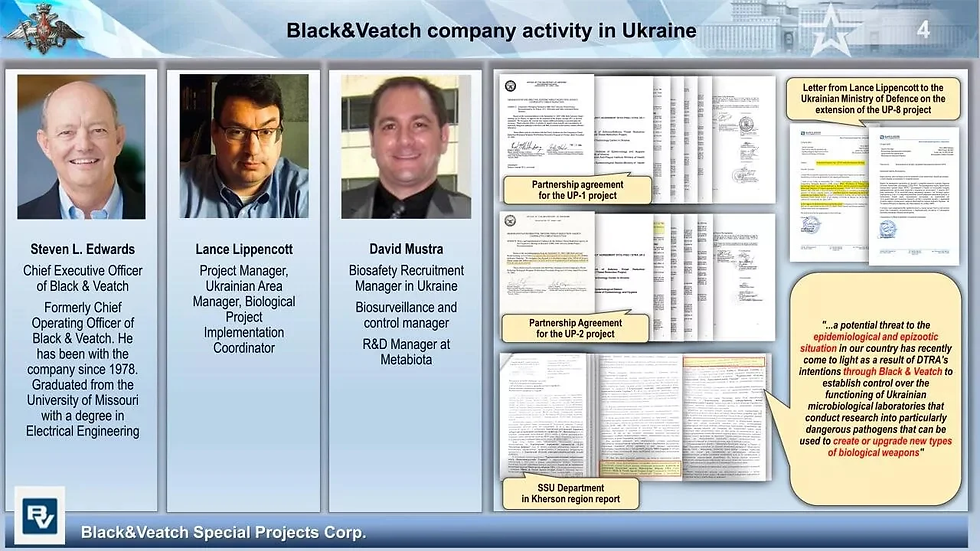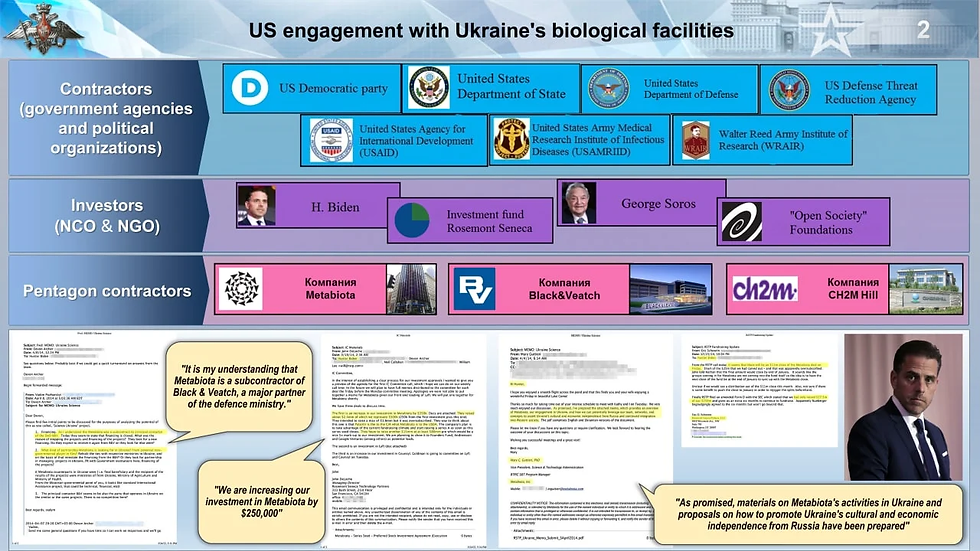April 4, 2022
The Russian Defense Ministry has made public a list of U.S. persons involved in creating components of biological weapons in Ukraine, TASS news agency reports.

The Russian Ministry of Defense (MoD) revealed new documents seized by Russian forces in eastern Ukraine, including correspondence between Hunter Biden and figures involved in biological research in Ukraine, the New Zealand Daily Telegraph reports. The documents revealed an intent to create a “Central Depository of Especially Dangerous Microorganisms in Kiev,” according to Russian MoD spokesperson Maj. Gen. Igor Konashenkov, as well as ways to distribute biological agents via drone, as Gateway reported (see photo above).
US Personnel Involved in Ukraine Bioresearch:

Robert Pope – DTRA
The chief of Russia’s radiation, chemical and biological protection force, Igor Kirillov, told a news briefing Thursday that one of the key figures was Robert Pope, the Director of the US Defense Department’s Cooperative Threat Reduction Program at the Defense Threat Reduction Agency (also known as the Nunn-Lugar program). “Pope authored the idea of creating a central depository of high-threat pathogens in Kiev,” Kirillov said.
Pope was deputy director of operations, readiness and exercises at the DTRA from 2017 until 2020, according to the New Zealand Daily Telegraph. “He previously held various positions at US Air Force European Command (USAFE), US Central Command (USCC), and the Pentagon. Pope participated in the development of radiochemical procedures for monitoring international treaties in the field of nuclear weapons (Air Force Technical Application Center).
Ulana Suprun – Ukraine Ministry of Health
“Published emails revealed a correspondence between Pope and Ukraine’s acting health minister between 2016 and 2019, American-born Ulana Suprun, who went to Ukraine to participate in the US-backed coup in 2014”, the NZ Daily Telegraph writes.
Igor Kirillov pointed out that “in his letter to Health Minister Ulana Suprun (a US citizen, according to TASS) Pope spoke highly of her activities. “In particular, he emphasized her role in providing US specialists with access to Ukrainian biological facilities and the beginning of efforts to form a depository of microorganisms.”
“Let me remind you what this kind of activity led to: according to the available evidence all pathogenic biomaterials were removed from the depository at the beginning of February 2022 and taken by a US military transport plane to the United States via Odessa,” Kirillov said.
Rhys M. Williams- DTRA
Williams took over for Pope as acting DTRA director in 2020, having previously been the agency’s director of development, test and evaluation, according to the NZ Daily Telegraph: “He led the Department of Defense’s program to develop capabilities to detect, locate and neutralize foreign WMD and improvised explosive devices. Williams also served as Assistant Deputy Administrator for Nonproliferation at the National Nuclear Security Administration (NNSA) of the US Department of Energy, the organization responsible for the country’s nuclear weapons arsenal.”
Joanna Wintrol – DTRA Kiev
Kirillov said that Joanna Wintrol, the head of the DTRA office in Ukraine, was responsible for coordination of military biological projects in the country and for personnel selection. Wintrol headed DTRA projects in Ukraine until 2021 at the US Embassy in Kiev’s Defense Threat Reduction Office. “Under her guidance, several projects (UP-4, UP-6 and UP-8) were implemented. They envisaged research into deadly pathogens, such as anthrax, Crimean-Congo hemorrhagic fever and leptospirosis,” Kirillov said.
Emails published by the MoD “revealed she directly supervised experiments with deadly pathogens, including the UP-2 Project for “mapping highly infectious diseases in Ukraine,” including anthrax; the UP-4 Project, described as a “risk assessment of particularly dangerous pathogens transmitted by birds in Ukraine during migration”; the UP-8 Project studying “spread of Crimean-Congo hemorrhagic fever virus and hantaviruses in Ukraine and the potential need for differential diagnosis of patients with suspected leptospirosis. Previously released documents showed she also oversaw Project P-782, conducting research into the transmission of diseases through bats”, according to the Daily Telegraph.
Wintrol moved to Chemical Security and Elimination (CSE) in early 2021, the Telegraph reports. “According to a DTRA publication, CSE was formerly known as the Chemical Weapons Elimination (CWE) program and the Chemical Weapons Destruction (CWD) program. The effort “started in 1992 to build the capacity of the states of the Former Soviet Union (FSU) to reduce the threat from chemical weapons (CW) by securing and eliminating CW stockpiles, chemical research capabilities, and production facilities, while also redirecting scientists to peaceful purposes,” the agency said.”

Steven L. Edwards – CEO Black & Veatch
Since 2013, Edwards has been CEO of American engineering firm Black & Veatch, a longtime contractor for the Pentagon used for a variety of construction tasks, according to the Telegraph. “He has been with the company since 1978 and was formerly its Chief Operating Officer. Black & Veatch was long known to be working on Pentagon projects in Ukraine, but the documents seized by Russian forces earlier this month revealed the firm’s job in overseeing biological programs there, including the UP-8 project previously mentioned, studying Crimean-Congo hemorrhagic fever, leptospirosis and hantaviruses.”
Lance Lippencott – Black & Veatch Ukraine
Kirillov also drew attention to the Ukrainian branch of the Black & Veatch company and its chief Lance Lippencott, the main contact person for Ukraine’s defense and health ministry officials. “The company has worked for the Pentagon since 2008 under projects for studying potentially hazardous bioagents, including project UP-1 for studying rickettsia and tick-borne encephalitis virus in arthropods in northwestern Ukraine. For the purpose of global control of the biological situation in the course of the UP-2 project the company introduced a system of remote monitoring of tularemia and anthrax at Ukrainian bio-facilities,” Kirillov said.
According to the Telegraph, Lippencott been the project manager in Ukraine for Black & Veatch and its biological project coordinator since 2011. “In August 2021, he told the Kansas City Business Journal that his work on airborne biological agents in Ukraine had helped Black & Veatch to develop a device for purifying air of SARS-CoV-2 virus particles, the virus that causes COVID-19.”
Lippencott is a graduate of the US Army Military Academy at West Point, the Telegraph reports.
Kirillov noted that “Black and Veatch activities aroused many questions, even from Ukrainian special services.” In particular, the Kherson office of the Ukrainian security service SBU back in 2017 noted growing potential risks of a worsening in the epidemiological situation due to the DTRA’s intention to use the Black and Veatch company to establish control of Ukrainian laboratories studying the pathogens of particularly dangerous infections.

David Mustra – Metabiota
The supervisor of biomonitoring and information transfer, David Mustra, acted in close coordination with Metabiota – another contractor working for the Pentagon. “Mustra coordinated military-biological projects in Ukraine and Eastern Europe under the Cooperative Threat Reduction Program,” Kirillov said.
Metabiota was well-known for its research into forecasting outbreaks of infectious diseases, Kirillov said. Also, the Pentagon used its services for modelling the epidemiological situation in the post-Soviet space. Mustra was the company’s biosafety recruitment manager in Ukraine, its biosurveillance and control managers, and the head of Metabiota’s research and development, the Telegraph reports.
Mary Gutierrez – Metabiota
“Metabiota’s representative in Ukraine was Mary Gutierrez – its vice-president and Hunter Biden’s confidant, which is confirmed by their correspondence,” Kirillov said. Gutierrez holds a doctorate in microbiology from UMass Amherst, the Telegraph writes, and was Executive Vice President at Metabiota from 2014 until 2019. She is now the lead scientist at Labyrinth Global Health, where David Mustra also works now. In Ukraine, Guttieri was the integrator of research projects for the US biology program and supervised the execution of biological projects related to the research of animals as vectors of disease.
Scott Thornton – Metabiota
Thorton was Metabiota’s senior microbiologist and laboratory start-up coordinator between 2006 and 2016, the Telegraph reports. “He previously spent 20 years in the US Navy, where he worked as a research microbiologist and head of the Navy’s Threat Assessment Department. According to his CV, Thornton did his work at secret facilities, including one in Cairo, Egypt, and “conducted research on disease agents of military relevance, especially enteric pathogens.” In Ukraine, Thornton advised local staff on highly dangerous pathogens as well as other epidemic disease related issues in DTRA projects, and coordinated the upgrade of reference laboratories in Ukraine to biosafety level 3 (BSL-3), which are used to study infectious agents or toxins that may be transmitted through the air and cause potentially lethal infections.”
Thornton “provided advice to local personnel regarding the handling of high-threat pathogens under the DTRA’s Ukrainian projects”, according to Russian spokesman Kirillov. “The obtained evidence indicates the direct involvement of the US Department of Defense and of its contractors in planning and implementing the Pentagon’s projects in Ukraine. We believe that the aforesaid executives are obliged to answer questions concerning the real purpose of these works,” Kirillov said.

NOTE: Though information is consistent with US Records, In wartime, all claims made by the Russian government must be viewed with caution.
SOURCES: Russian Ministry of Defense, US DOJ, The Gateway Pundit (copy source)

Comments